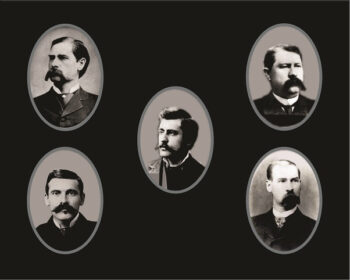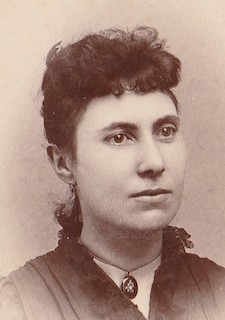
“Wyatt Earp and the Battle of the O.K. Corral,” a painting by the English School.
Nov/Dec 2022 (Volume 14, Issue 6)
By Christine White
More than 140 years after the smoke from the gunfight at the O.K. Corral dissipated into the desert air in Tombstone, Ariz., the legend of one of the Old West’s most famous gunfights still burns hot in the minds of those fascinated by the events of the morning of Oct. 26, 1881.
The story of Wyatt Earp, his brothers, and their feud with the Cowboys has filled volumes of books and entertained generations of fans of the Old West with movies like 1957’s “Gunfight at the O.K. Corral” and 1993’s “Tombstone.”

This photo of Wells Spicer in 1875 was cropped from a group photo of John D. Lee’s defense team for Lee’s second murder trial.
What often gets overlooked, however, is the connection that Iowa has to the legendary gunfight that lasted only 30 seconds. Key figures in the historic event were former residents of the Hawkeye State, including the Earps (Wyatt, Virgil and Morgan) and the McLaurys (Frank and Tom, both of whom were killed by the Earps and their friend John “Doc” Holliday). Other former Iowans who were in Tombstone that day were Wyatt Earp’s common-law wife Mattie Blaylock and Holliday’s common-law wife “Big Nose” Kate Elder. What’s more, the judge that presided over the hearings regarding the gunfight at the O.K. Corral, was none other than a former attorney from Tipton, Wells Spicer. This is his story.
Wells W. Spicer was born in New York in 1831. Around 1845, Spicer and his family moved to Tipton, where Spicer completed high school. According to N.C. Moffett, a former printer and co-owner of the Tipton Advertiser, Spicer then studied law with Tipton judge S.A. Bissell. Moffett described Spicer’s personality as “very social, jovial, unassuming.”
During the mid-1850s, Iowa lacked a law school or state bar association. The 1851 Code of Iowa stated that a man wishing to practice law must be a “white male citizenof the United States who is actually an inhabitant of this state … who possesses the requisite learning … and [who has] … good moral character.”
In 1853, Spicer took the oath in Iowa City (when it was the state capitol), briefly joined Bissell’s law practice, then opened his own office the following year.
Making money, however, was difficult. “Lawing is not well patronized in this county,” Spicer lamented, “… lawyers cannot depend on their professions alone for support. They must … go to work at whatever they can to earn a living.” So he became a law partner with H.C. Piatt and augmented his income as a notary public, a land agent, an insurance agent and co-publisher of a Cedar County plat map. Spicer also assumed co-editorship of what became the Tipton Advertiser and later became owner of the newspaper for four years.
Spicer was active in the community. He helped draft a new city charter for Tipton in 1855. He joined the Tipton Guards (a local militia) in 1856 as a third lieutenant. Spicer became a Cedar County judge and arranged a contract for the construction of a new courthouse in Tipton in 1857. He became an officer of the newly organized Siloam Chapter No. 19, Royal Arch Masons. And when the first Cedar County fair was held in 1861, Spicer was asked to address fairgoers.
In 1856, 25-year-old Spicer married a local woman, 16-year-old Abbie Gilbert. According to census records, their son Earnest was born approximately eight years later.
TO READ THE ENTIRE STORY AND OTHER FASCINATING STORIES ABOUT IOWA HISTORY, subscribe to Iowa History Journal.
Other Iowans linked to the gunfight at the O.K. Corral
Earp Brothers

A photo compilation of Wyatt Earp (upper left), Morgan Earp (center), Virgil Earp (upper right), James Earp (lower right) and “Doc” Holliday (lower left).
Wyatt Earp, a legendary lawman and gambler in the Old West, including Dodge City, Deadwood and Tombstone, is also remembered for taking part in the gunfight at the O.K. Corral on Oct. 26, 1881, in Tombstone, Ariz., during which three outlaw Cochise County Cowboys were killed — including fellow Iowans the McLaury brothers — by Wyatt and his brothers, Virgil and Morgan, and their friend John “Doc” Holliday.
In March 1849 or early 1850, the Earp family bought a 160-acre farm seven miles northeast of Pella, but lived in town most of the time including a rented apartment in the Van Spanckeren Row House.
McLaury Brothers

Tom McLaury, Frank McLaury and Billy Clanton (left to right) lie dead after the gunfight at the O.K. Corral. This is the only known photo of 19 year-old Billy Clanton.
Frank and Tom McLaury were outlaws who owned a ranch outside of Tombstone in the Arizona Territory during the 1880s. They had ongoing conflicts with lawmen Wyatt, Virgil and Morgan Earp and threatened the Earps because they interfered with the Cowboys’ illegal activities. On Oct. 26, 1881, Frank and Tom — as well as Billy Clanton — were killed in the gunfight at the O.K. Corral.
Frank (whose birth name was Robert) and Tom were two of 11 children born to Margaret Rowland and Robert Houston McLaury, who moved the family to a new farm near Belle Plaine in Iowa’s Benton County in 1855, where Robert also practiced law. Margaret died in 1859 when an epidemic of typhoid swept through their community and Robert remarried in 1860. Their older brother, Edwin, joined the 14th Iowa Volunteers and was captured and imprisoned in Macon, Ga. After the Civil War the family moved to Buchanan County to farm in an unincorporated portion outside Hazelton Township known as Buffalo. Frank and Tom helped their father work the 800 acres before both left Iowa in 1878 for Texas where they worked cattle drives and eventually landed a job working for Old Man Clanton in Arizona where they befriended Ike Clanton and “Curly Bill” Brocius.
Mattie Blaylock

Celia Ann “Mattie” Blaylock was Wyatt Earp’s common-law wife from about 1873 until mid-1881. After Wyatt left her for another woman, she later moved to Pinal City, Arizona Territory, where she apparently overdosed on laudanum and alcohol.
Celia Ann “Mattie” Blaylock was a prostitute who became Wyatt Earp’s common-law wife from about 1873 until mid-1881. She was born in 1850 in Monroe Township, Johnson County, near Fairfax, to Henry Blaylock and Elizabeth “Betsey” Vance, one of the couple’s three children. She was raised there on a small Iowa farm that her father had obtained in 1846. Reportedly, her parents were stern and Celia attended Sunday school, learned biblical parables and was taught to live by the Ten Commandments.
However, Celia had no desire to live on the farm the rest of her life and ran away with her younger sister, Sarah, to avoid farm life. They likely headed west to one of the growing towns along the Kansas-Iowa-Missouri border. She soon adopted her alias, “Mattie,” and court records show that she became a prostitute in 1872 in Fort Scott, then later in Dodge City, where she began a relationship with Earp after April 1876. The couple left Dodge City in September 1879 and eventually moved to Tombstone, Ariz., in December that year. After Wyatt left Mattie for another woman, she later moved to Pinal City, Arizona Territory, where she apparently overdosed on laudanum and alcohol on July 3, 1888.
‘Big Nose Kate’ Elder

“Big Nose Kate” Horony, circa 1890, about age 40.
Mary Katherine Horony Cummings, known as “Big Nose Kate,” was a prostitute and longtime companion and common-law wife of Old West gunfighter John “Doc” Holliday. She was born on Nov. 7, 1850, in Ersekujvar, Kingdom of Hungary, the second daughter of a Hungarian physician and teacher who immigrated to New York City, N.Y., in 1860. Two years later, the Horony family settled in a predominantly German area of Davenport, where her parents died in 1865. Kate and her sister, Wilma, were placed under the care of her brother-in-law, followed by Otto Smith in 1870. At age 16, Kate ran away from her foster home and stowed away on a riverboat bound for St. Louis, where it was recorded in 1869 that she worked as a prostitute.
In 1874, Kate was fined for working as a “sporting woman” at a brothel in Dodge City, Kansas, run by James Earp’s wife. In 1876, she moved to Fort Griffin, Texas, where in 1877 she met Holliday.
